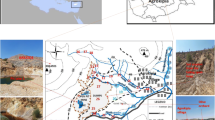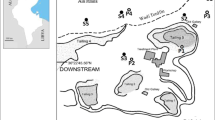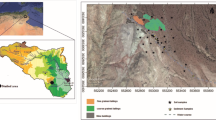Abstract
With respect to acidic, cyanide-laced tailings, the data about in situ toxicity and biological activity in highly polluted environment are often lacking. The aim of this study was to assess the microbial characteristics, composition of oribatid mite species, and level of genotoxic impact on plants in the area of inactive tailings pond (Horná Ves, Kremnica region). Sampling of the tailings, soils and selected plant species was carried out in spring of 2012. Trace element analysis (inductively coupled plasma emission and mass spectrometry) showed that concentration of Pb, Zn, and Cu in the tailings is approximately in thousands of ppm (mg kg−1). Amount of lead exceeded 16,000 mg kg−1, which is perceived as the biggest threat with respect to possible toxicity. The risk is accentuated by extremely acidic pH of the tailings material which approached 2. In such conditions great mobility of (divalent) heavy metal cations is expected. The total cyanide concentration in the tailings was 472 mg kg−1. Results of performed tests and measurements suggest that microbial activity at the tailings site (and its close environment) is hampered markedly. In the sludge material we detected low abundance of soil bacteria (2.08 × 104 CFU) and predominance of slowly growing K-strategists. On the other hand, the content of microbial C in the sludge sample was not too low, considering its extreme acidity and high amount of risk elements. In the same sample, just one mite species, Oppiella (O.) uliginosa (Willmann 1919), was identified. Also in case of the dam site the abundance of mites was considerably lower in comparison to reference sample. Values of Oribatida abundance were in positive correlation with values of microbial biomass carbon. Results of the pollen grain abortivity test, applied in situ on chosen plant species, indicated substantial presence of genotoxicity in the environment. Total induction index of tailings pond reached 3.59(±2.4) which expresses also total load of locality, comparing to natural biotope. In case of the technogenic sediment, the value was more than three times higher.





Similar content being viewed by others
References
Act. 86/278/EEC European Union Council´s Directive (1986) The Council of the European Communities, Council Directive of 12 June 1986 on protection of the environment, and in particular of the soil, when sewage sludge is used in agriculture
Carneiro MFH, Ribeiro FQ, Fernandes-Filho FN, Lobo DJA, Barbosa F Jr, Rhoden CR, Mauad T, Saldiva PHN, Carvalho-Oliveira R (2011) Pollen abortion rates, nitrogen dioxide by passive diffusive tubes and bioaccumulation in tree barks are effective in the characterization of air pollution. Environ Exp Bot 72:272–277
Caruso T, Bernini F, Bargagli R, Migliorini M, Pigino G (2007) The Berger-Parker index as an effective tool for monitoring the biodiversity of disturbed soils: a case study on Mediterranean oribatid (Acari: Oribatida) assemblages. Biodivers Conserv 16:3277–3285
Cheng WX, Zhang QL, Coleman DC, Carroll CR, Hoffmann CA (1996) Is available carbon limiting microbial respiration in the rhizosphere? Soil Biol Biochem 28:1283–1288
Chu G, Wakelin SA, Condron L, Stewart A (2010) Effect of soil copper on the response of soil fungal communities to the addition of plant residues. Pedobiologia 53:353–359
Culliney TW (2013) Role of arthropods in maintaining soil fertility. Agriculture 3:629–659
Dilly O, Munch JC (1998) Ratios between estimates of microbial biomass content and microbial activity in soils. Biol Fertil Soils 27:374–379
Dold B (2014) Evolution of acid mine drainage formation in sulphidic mine tailings. Minerals 4:621–641
Donato DB, Nichols O, Possingham H, Moore M, Ricci PF, Noller BN (2007) A critical review of the effects of gold cyanide-bearing tailings solutions on wildlife. Environ Int 33:974–984
Ellis S, Howe MT, Goulding KWT, Mugglestone MA, Dendooven L (1998) Carbon and nitrogen dynamics in a grassland soil with varying pH: effect of pH on the denitrification potential and dynamics of the reduction enzymes. Soil Biol Biochem 30(3):359–367
Farmer VC (1974) The infrared spectra of minerals. Miner Soc, London 539 pp
Favas PJC, Pratas J, Gomes MEP, Cala V (2011) Selective chemical extraction of heavy metals in tailings and soils contaminated by mining activity: environmental implications. J Geochem Explor 111(3):160–171
Feketeová Z, Hulejová Sládkovičová V, Mangová B, Šimkovic I (2015) Biological activity of the metal-rich post-flotation tailings at an abandoned mine tailings pond (four decades after experimental afforestation). Environ Sci Pollut Res 20:12174–12181
Gil-Sotres F, Trasar-Cepeda C, Leirós MC, Seoane S (2005) Different approaches to evaluating soil quality using biochemical properties. Soil Biol Biochem 37:877–887
Gregušková E, Mičieta K (2013) Phytoindication of the ecogenotoxic effects of vehicle emissions using pollen abortion test with native flora. Pol J Environ Stud 22(4):1069–1076
Gulvik ME (2007) Mites (Acari) as indicators of soil biodiversity and land use monitoring: a review. Pol J Ecol 55:415–440
Hammer O, Harper DAT, Ryan PD (2001) PAST: paleontological statistics software package for education and data analysis. Paleontol Eletron 4(1):1–9
Helma C, Eckl P, Gottmann E, Kassie P, Rodinger W, Steinkellner H, Wind-Passinger C, Schulte-Hermann R, Knasmüller S (1998) Genotoxic and ecotoxic effects of groundwaters and their relation to routinely measured chemical parameters. Environ Sci Technol 32:1799–1805
Kasaini H, Kasongo K, Naude N, Katabua J (2008) Enhanced leachability of gold and silver in cyanide media: effect of alkaline pre-treatment of jarosite minerals. Miner Eng 21:1075–1082
Kjeldsen P (1999) Behaviour of cyanides in soil and groundwater: a review. Water Air Soil Pollut 115:279–307
Knasmüller S, Gottmann E, Steinkellner H, Fomin A, Pickl C, Paschke A, God R, Kundi M (1998) Detection of genotoxic effects of heavy metal contaminated soils with plant bioassays. Mutat Res 420:37–48
Kuyucak N, Akcil A (2013) Cyanide and removal options from effluents in gold mining and metallurgical processes. Miner Eng 50–51:13–29
Liu X, Herbert SJ, Hashemi AM, Zhang X, Ding G (2006) Effects of agricultural management on soil organic matter and carbon transformation—a review. Plant Soil Environ 52(12):531–543
Liu J, Hua Z-S, Chen L-X, Kuang J-L, Li S-J, Shu W-S, Huang L-N (2014) Correlating microbial diversity patterns with geochemistry in an extreme and heterogenous environment of mine tailings. Appl Environ Microbiol 80(12):3677–3686
Madejová J, Janek M, Komadel P, Herbert H-J, Moog HC (2002) FTIR analyses of water in MX-80 bentonite compacted from high salinary salt solution systems. Appl Clay Sci 20:255–271
Majer BJ, Tscherko D, Paschke A, Wennrich R, Kundi M, Kandeler E, Knasmüller S (2002) Effects of heavy metal contamination of soils on micro-nucleus induction in Tradescantia and on microbial enzyme activities: a comparative investigation. Mutat Res 515:111–124
Margalef R (1958) Information theory in ecology. Gen Syst 3:36–71
Menhinick EP (1964) A comparison of some species-individual diversity indices applied to samples of field insects. Ecology 45:859–861
Mičieta K, Murín G (1996) Microspore analysis for genotoxicity of polluted environment. Environ Exp Bot 36(1):21–27
Mišík M, Mičieta K, Solenská M, Mišíková K, Pisarčíková H, Knasmüller S (2007) In situ biomonitoring of the genotoxic effects of mixed industrial emissions using the Tradescantia micronucleus and pollen abortion tests with wild life plants: demonstration of the efficacy of emission controls in an Eastern European city. Environ Pollut 145:459–466
Murín A (1995) Basic criteria for selection of plant bioindicators from regional flora for monitoring of an environmental pollution. Biologia 50:37–40
Olszanowski Z (1996) A monograph of the Nothridae and Camisidae of Poland (Acari: Oribatida: Crotonoidea). Int J Invertebr Taxon 16:3277–3285
Pavlitshenko PG (1994) A guide to the ceratozetoid mites (Oribatei, Ceratozetoidea) of Ukraine. Naciolalnoi Akademii Nauk Ukraini, Kiev 143 pp
Rennert T, Kaufhold S, Mansfeldt T (2007) Identification of iron-cyanide complexes in contaminated soils and wastes by Fourier transform infrared spectroscopy. Environ Sci Technol 41:5266–5270
Rousk J, Brookes PC, Bååth E (2009) Contrasting soil pH effects on fungal and bacterial growth suggest functional redundancy in carbon mineralization. Appl Environ Microbiol 75(6):1589–1596
Rousk J, Bååth E, Brookes P, Lauber CL, Lompone C et al (2010) Soil bacterial and fungal communities across a pH gradient in an arable soil. ISME J 1:1–12
Schinner F, Öhlinger R, Kandeler E, Margesin R (1993) Bodenbiologische Arbeitsmethoden. Springer, Berlin 389 pp
Seguel A, Cumming JR, Klugh-Stewart K, Cornejo P, Borie F (2013) The role of arbuscular mycorrhizas in decreasing aluminium phytotoxicity in acidic soils: a review. Mycorrhiza 23:183–197
Shang H, Yang Q, Wei S, Shang H, Wang J (2012) The effects of mercury and lead on microbial biomass of paddy soil from southwest of China. Proc Environ Sci 12:468–473
Shanonn CE, Weaver W (1963) The matematical theory of communication. University of Illinois Press, Urbana 117 pp
Sheldon AL (1969) Equitability indices: dependence on the species count. Ecology 50:466–467
Swartjes FA (1999) Risk-based assessment of soil and groundwater quality in the Netherlands: standards and remediation urgency. Risk Anal 19:1235–1249
Tischler W (1976) Einführung in die Ökologie. Gustav Fischer, Stuttgart
Uhl M, Plewa MJ, Majer BJ, Knasmüller S (2003) Basic principles of genetic toxicology with an emphasison plant bioassays. In: Maluszynska J, Plewa M (eds) Bioassays in plant cells for improvement ofecosystem and human health. Wydawnictvo Uniwersytetu Ślaskiego, Katowice, p 150
van Straalen NM (1998) Evaluation of bio-indicator systems derived from soil arthropod communities. Appl Soil Ecol 9:429–437
Vance ED, Brookes PC, Jenkinson DS (1987) An extraction method for measuring microbial biomass C. Soil Biol Biochem 19:703–707
Vodyanitskii YN (2013) Contamination of soils with heavy metals and metalloids and its ecological hazard (analytic review). Eur Soil Sci 46(7):793–801
Wakelin SA, Anand RR, Reith F, Gregg AL, Noble RRP, Goldfarb KC, Andersen GL, DeSantis TZ, Piceno YM, Brodie EL (2012) Bacterial communities associated with a mineral weathering profile at a sulphidic mine tailings dump in arid Western Australia. FEMS Microbiol Ecol 79:298–311
Wang YP, Shi J, Wang H, Lin Q, Chen X, Chen Y (2007) The influence of soil heavy metals pollution on soil microbial biomass enzyme activity and community composition near a copper smelter. Ecotoxicol Environ Saf 67:75–81
Weigmann G (2006) Hornmilben (Oribatida). Die Tierwelt Deutschlands, Begründet 1925 von Friedrich Dahl. 76. Teil. Goecke et Evers, Keltern, Deutschland, 75–82
WRB (IUSS WORKING GROUP WRB) (2006) World Reference Base for Soil Resources 2006, 2nd edn. World soil resources reports, 103, FAO, Rome
Acknowledgments
This study was financially supported by Slovak National Grant Agency, Projects VEGA No. 1/0380/13; 1/0886/13; 1/0482/15 and Comenius University Grant Agency for young Researchers, Project No. 385/2014.
Author information
Authors and Affiliations
Corresponding author
Ethics declarations
Conflict of interest
The authors declare that they have no conflict of interest.
Rights and permissions
About this article
Cite this article
Feketeová, Z., Sládkovičová, V.H., Mangová, B. et al. Biological properties of extremely acidic cyanide-laced mining waste. Ecotoxicology 25, 202–212 (2016). https://doi.org/10.1007/s10646-015-1580-z
Accepted:
Published:
Issue Date:
DOI: https://doi.org/10.1007/s10646-015-1580-z




